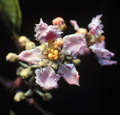
DMT-Nexus member
Posts: 99 Joined: 03-Sep-2012 Last visit: 26-Mar-2013 Location: The moment
|
I got it from the same vendor you mentioned, and it turned a deep red when boiling.
|
|
|
|
|

DMT-Nexus member
Posts: 138 Joined: 23-Sep-2012 Last visit: 02-Dec-2015 Location: GreatLakes
|
What a great amount of information- really helpful, but now I have a ton of questions...
If some vendors have their IDs wrong, or are relying on local names, how can we identify what we have?
I purchased shredded caapi, labeled only "Caapi-Peruvian"on the website, and it was delivered in bags that say "Ayahuasca- Peruvian". So since it is not full pieces, it's very finely shredded with some black, powdery dust in the bag, I can't see the cross-section to help ID it. I brewed it last weekend, and it was golden colored until reduced and now that is black/really dark. I drank what I calculated was 10g to get to know the vine, and felt pretty distinct effects, changes in my vision, orientation (needed to lie down for sure) purged a couple times, hours apart, but felt good, warm (sweaty), some visual distortion, but all in all, a warm, friendly, contemplative afternoon with a good nap and dreams. Sounded rather similar to what others have reported in this thread.
I'm new to this, so I couldn't tell you if it smelled like other caapi, tasted like it, nothing. So I shared some with a friend, and they mentioned that it looks way different than two types of caapi that they have, I think labeled "red" and "white"... I have asked that they take pics of their brews when they make them, just for more reference photos. I find the photos really helpful.
So, how would I go about figuring this ID out?
Of course, if it does the trick, does it matter whether it is Alicia or B. caapi? Are there any other considerations about this possibility of it being Alicia- aside from what I have read about dosing- that it seems to be stronger/more active than B. caapi? considerations such as pairing it with admixtures? What about the notion of boiling this vine longer, reducing it to a thicker product? This was brought up a couple times, but not a lot of discussion about it.
I did take pictures throughout the process, and have more dry matter here to make more when I need it. Would these be of any help in this thread?
All the work that everyone has put into this project is amazing and so helpful. It is mind boggling to me, even tho I studied horticulture for several years, I know nothing about the kinds of analysis that you all are doing, and find it fascinating. Thank you all so much- greatly appreciated.
|
|
|

DMT-Nexus member

Posts: 14191 Joined: 19-Feb-2008 Last visit: 22-Apr-2024 Location: Jungle
|
Look under UV light. Does the brew glow? If not and its too concentrated, dilute and check again. If it shines under UV, its probably B. caapi or related harmala-containing vines, so you should brew considering the normal recomendations for ayahuasca apply. If you get any of the other vines that dont contain harmalas, you're stepping on a more unknown territory.
You can also look into TLC to identify presence of main alkaloids in your plant/brew, check my signature or pm me for more info.
In the future we hope to have better ways to identify samples but for the moment the best we can do is do the above tests, as well as email the supplier and asking for further info if they have (where is plant from, if there are pictures of full plant / unshredded bark cross sections, how it was identified, if they have seeds from same plant, etc).
|
|
|

DMT-Nexus member
Posts: 138 Joined: 23-Sep-2012 Last visit: 02-Dec-2015 Location: GreatLakes
|
AluminumFoilRobots wrote:I've done some research and am about to do a bit more, but I do have this question: Am I correct in thinking that "caupuri" means "knotted" and "ourinhos" means "smooth"? In the Intro Essay thread, Ayahuasquero Arriving, he mentions both of these in relation to usage in Brazil. I can't find a meaning specific to "caupuri" as it could be of native language origin. Is this name used in Spanish speaking countries too? "Ourinhos" just means "little gold", like "Goldy"- it does not specifically reference the texture of the bark or vine. I assumed it referenced the color of the brew. AluminumFoilRobots wrote:I was reading yesterday that in some parts of Ecuador smooth caapi is "Men's" ayahusacsa and curvy (which I assumed meant knotted?) is "women's ayahuascsa".
Thanks guys! I am really glad that the collaborative research area got started! Curious about this too- seems that I read another reference to this, or that caapi is felt to be masculine and chacruna has more feminine energy- the opposite of what I have read and understood here on this site. More good things to look into, more research, better understanding.
|
|
|

DMT-Nexus member
Posts: 138 Joined: 23-Sep-2012 Last visit: 02-Dec-2015 Location: GreatLakes
|
endlessness wrote:Look under UV light. Does the brew glow? If not and its too concentrated, dilute and check again. If it shines under UV, its probably B. caapi or related harmala-containing vines, so you should brew considering the normal recomendations for ayahuasca apply. If you get any of the other vines that dont contain harmalas, you're stepping on a more unknown territory. I'm having a 'duh" moment- is UV = black light? If so, I will check it once I find my old one from black light poster days. lol Thanks Endlessness! vc é carioca, não é? muito obrigada. Did you read that text that sbarret77 mentioned in that Intro thread? Does it make any reference to these other vines, or the varieties that you all have been trying to get straightened out? curious if I want to dive into it- as I'm still learning portugues and it's probably waaay over my head.
|
|
|

Wide eyed and hopeful
Posts: 492 Joined: 18-Sep-2012 Last visit: 02-May-2018 Location: Elysian Fields
|
Yes UV=Blacklight.  Here's a photo in case it's helpful for I.D. at all. The one on the left was labeled peruvian yellow, the one on the right is peruvian white, both from shamansgarden. In the middle is Julz mystery material from another supplier. Based on the apparent potency, possibly Alicia, or one of the types of "black"? Crazyhorse attached the following image(s):  IMG_3750.JPG (1,207kb) downloaded 325 time(s).No direction but to follow what you know,
No direction but a faith in her decision,
No direction but to never fight her flow,
No direction but to trust the final destination.
|
|
|

DMT-Nexus member
Posts: 138 Joined: 23-Sep-2012 Last visit: 02-Dec-2015 Location: GreatLakes
|
Wow, it is kinda different. Does it smell different?
I chewed on some of it one day, don't know to what effect, but the trees around here looked incredible that day. hrmm.
|
|
|

Wide eyed and hopeful
Posts: 492 Joined: 18-Sep-2012 Last visit: 02-May-2018 Location: Elysian Fields
|
Smells pretty much the same to me, if it's different it's not TOO different. The blacklight test is probably going to be the best way to be sure. No direction but to follow what you know,
No direction but a faith in her decision,
No direction but to never fight her flow,
No direction but to trust the final destination.
|
|
|

DMT-Nexus member
Posts: 138 Joined: 23-Sep-2012 Last visit: 02-Dec-2015 Location: GreatLakes
|
wow, the link in endlessness's sig line is great- the one about how analytical methods work. very helpful. Thanks!
|
|
|

DMT-Nexus member

Posts: 14191 Joined: 19-Feb-2008 Last visit: 22-Apr-2024 Location: Jungle
|
Você também é carioca?  Yeah UV light is just any black light. Crazyhorse, we can't identify plants by potency, neither by how it looks shredded. Again, test with UV light, if it glows, it's not Alicia, but rather normal B. caapi or B. muricata.
|
|
|

omnia sunt communia!

Posts: 6024 Joined: 29-Jul-2009 Last visit: 29-Oct-2021
|
Julz wrote:AluminumFoilRobots wrote:I've done some research and am about to do a bit more, but I do have this question: Am I correct in thinking that "caupuri" means "knotted" and "ourinhos" means "smooth"? In the Intro Essay thread, Ayahuasquero Arriving, he mentions both of these in relation to usage in Brazil. I can't find a meaning specific to "caupuri" as it could be of native language origin. Is this name used in Spanish speaking countries too? "Ourinhos" just means "little gold", like "Goldy"- it does not specifically reference the texture of the bark or vine. I assumed it referenced the color of the brew. Imo, sbarret77's post introduced some real confusion into this issue (perhaps not a bad thing, if it means we have been presented with the full magnitude of the "snare" ). The sample of ourinhos that the Nexus tested came back with significant amounts of ketotetrahydronorharmine, which is something scarcely mentioned in the literature. Therefore, his equating ourinhos with tucanaca raises a whole host of questions, unless the tested "ourinhos" was really one of the subdivisions of tucanaca to which he was unable to speak and assuming that the presence of this compound is essentially one of the things that causes it the tucanaca category to be subdivided. Julz, afaik, you won't find anything on the origin/definition of tucanaca or caupuri as the usage of these two terms in western/industrialized countries stems (apparently) from a 1996 D. McKenna lecture for which there is no information on, other than that is where Ratsch attributes his use of these varietals from (and subsequently, it looks as though others have cherry-picked Ratsch's bibliography, but no one has material from/about the content of that talk). Wiki • Attitude • FAQThe Nexian • Nexus Research • The OHTIn New York, we wrote the legal number on our arms in marker...To call a lawyer if we were arrested. In Istanbul, People wrote their blood types on their arms. I hear in Egypt, They just write Their names. גם זה יעבור
|
|
|

DMT-Nexus member
Posts: 138 Joined: 23-Sep-2012 Last visit: 02-Dec-2015 Location: GreatLakes
|
endlessness wrote:Você também é carioca?  Kkkkk, não... sou quase baiana!  snozzleberry wrote:Imo, sbarret77's post introduced some real confusion into this issue (perhaps not a bad thing, if it means we have been presented with the full magnitude of the "snare" ).
The sample of ourinhos that the Nexus tested came back with significant amounts of ketotetrahydronorharmine, which is something scarcely mentioned in the literature.
Therefore, his equating ourinhos with tucanaca raises a whole host of questions, unless the tested "ourinhos" was really one of the subdivisions of tucanaca to which he was unable to speak and assuming that the presence of this compound is essentially one of the things that causes it the tucanaca category to be subdivided.
Julz, afaik, you won't find anything on the origin/definition of tucanaca or caupuri as the usage of these two terms in western/industrialized countries stems (apparently) from a 1996 D. McKenna lecture for which there is no information on, other than that is where Ratsch attributes his use of these varietals from (and subsequently, it looks as though others have cherry-picked Ratsch's bibliography, but no one has material from/about the content of that talk). Snozz, then is what you're saying that most of the literature and botanical information is coming only through western sources, i.e. McKenna, Ratsch, lectures which we don't actually have access to, and not from local sources or research in Peru or Brazil. So rather like the vendors who may misidentify based on local nomenclature and not specific scientific methodology, what info we have is also filtered through a westerner/northerner's perspective and understanding- that there isn't really any specific research being done in Brazil or Peru, for instance, on plants used in ayahuasca, their varieties, scientific names, local and/or indigenous names? Has anyone here read that text that sbarret77 mentioned? Any idea of the content? Seems like a crazy shame to me... so much knowledge that has been/could be lost. A friend in Bahia, his grandmother was a curandera, and he and his brothers learned some things from her, but they check with each other to make sure they remember what grandma taught them. a great aunt helps them remember too, but neither are curanderos, just lay herbalists I guess. That in itself seems like a shame, a loss to their family. I hope that somehow, someday, I can go out with friends when they are collecting vines, to take a few photos, some notes, in general just to see the plants in their natural habitat, feel their energy. If the opportunity presents itself...
|
|
|

omnia sunt communia!

Posts: 6024 Joined: 29-Jul-2009 Last visit: 29-Oct-2021
|
Julz wrote:Snozz, then is what you're saying that most of the literature and botanical information is coming only through western sources, i.e. McKenna, Ratsch, lectures which we don't actually have access to Kind of. Pretty much all of the citations I have seen for caupuri/tucanaca can be traced back to the McKenna lecture (many indirectly, through citing Ratsch's work), but there's no info on that lecture, so it's a case of "follow the leader" in which western botany does not present any varieties of caapi and the original information that is being cited appears to not exist currently. Add in the relatively esoteric nature of this research, the disparities between nomenclatural systems and the lack of chemical analyses and the reasons for the magnitude of the confusion begins to become apparent. There is research being done in the indigenous context, but I'm not very well tapped into it and unfortunately much of my scholastically-mandated Portuguese has faded from my head (might be breaking out the Rosetta Stone in the upcoming year). Julz wrote:Has anyone here read that text that sbarret77 mentioned? Any idea of the content? I assume you are talking about the Bia Labate stuff? I've been hoping to, but I have not had time recently. She presented on some of the ethical issues enmeshed in ayahuasca use at Psychedemia, but I was unfortunately indisposed during her talk  She's also presenting at Psychedelic Science 2013 and once I address some of the stuff currently on my plate I had been planning on emailing D. McKenna over the caapi varieties as well as some of the Nexus' chemical analyses and could probably fairly easily modify the email and send her a similar one to see if she had any insight to share. Wiki • Attitude • FAQThe Nexian • Nexus Research • The OHTIn New York, we wrote the legal number on our arms in marker...To call a lawyer if we were arrested. In Istanbul, People wrote their blood types on their arms. I hear in Egypt, They just write Their names. גם זה יעבור
|
|
|

DMT-Nexus member
Posts: 138 Joined: 23-Sep-2012 Last visit: 02-Dec-2015 Location: GreatLakes
|
Cool, that would be great if you were able to contact her and McKenna, and if you got any responses. I am considering purchasing/reading the translated versions of her books, and then, depending on how my portugues is going- written and reading is not bad now, but probably not up to scientific level (I'll get there!), I would like to try to delve into some of her other books. I don't get the impression from her website/blog Bia Labate that her texts would contain so much from the plants' botanical/taxonomy perspective, but more from the socio-cultural perspective on ritual, shamanism and aya usage. Could be interesting though. Guess I am still floored that there isn't more botanical info, but then, I am coming from the total western old school northern hemisphere side of horticulture/commercial floriculture where plants have been well documented for centuries sometimes, not the emerging and/or unknown wealth of as yet unclassified plants of SA. Language is probably a huge barrier/factor with so many indigenous languages, and regional variations in layers upon that. It's bad enough going from academic portugues to regionalisms and slang and common usage on top of that. Ugh. Onward through the fog?
|
|
|

omnia sunt communia!

Posts: 6024 Joined: 29-Jul-2009 Last visit: 29-Oct-2021
|
Julz wrote:Guess I am still floored that there isn't more botanical info, but then, I am coming from the total western old school northern hemisphere side of horticulture/commercial floriculture where plants have been well documented for centuries sometimes, not the emerging and/or unknown wealth of as yet unclassified plants of SA. Well, one of the potential issues is the morphological/phytogeographic differences between some of these potential species/varieties. Western/industrial botany has very specific definitions and rules for classifying new species and varieties. It's quite possible that there are plants that do not meet our qualifications for classification as unique species/varieties (one of the things I want to ask McKenna is why he never published the caapi varieties...) but that are identified as unique botanical specimens to indigenous groups. Additionally, as you point out, it's quite possible we just haven't encountered enough material/specimens to classify these potential species/varieties. Then, somewhere in the middle of these two issues is the fact that there are a number of nomenclatural synonyms for many of these ayahuasca plants, which are listed by some ayahuasca centers as distinct plants, but are not recognized as distinct by western botany. I "resolved" a number of these nomenclatural issues in this thread in accordance with western botany, but that hardly tells us if there are truly distinct characteristics to these plants that our scientific experts are unaware of. Again, I think this is a good taste of the dizzying amount of information exchange that will be needed to truly engage these systems of knowledge with each other. Wiki • Attitude • FAQThe Nexian • Nexus Research • The OHTIn New York, we wrote the legal number on our arms in marker...To call a lawyer if we were arrested. In Istanbul, People wrote their blood types on their arms. I hear in Egypt, They just write Their names. גם זה יעבור
|
|
|

DMT-Nexus member
Posts: 138 Joined: 23-Sep-2012 Last visit: 02-Dec-2015 Location: GreatLakes
|
Ah, I get it. The western way just looks at morphology and only functions within its rule set, whereas indigenous society may treat plants with same/similar morphology as different varieties based on their pharmacological content, spirit energy, geographical location. It's not just names, it's the whole host of features that make each plant special- special to us and how we relate to it. It's like the western system has cut off the head (spirit) to spite the body, if you get my drift.
It's a shame in some ways that we "have" to follow the western system of classification, breaking it down into respective parts, as if they could be isolated from each other, much the way western medicine treats the body, health and disease.
|
|
|

metamorhpasizer
Posts: 995 Joined: 31-Mar-2009 Last visit: 17-Nov-2023 Location: US
|
great posts snozz and julz, also welcome to the board julz and thanks for contributing to our understanding of ayahuasca. I popped in to ask if anyone has tried a brew of ANY of kiwis other ayahuascas, and if they could post their results.. So far i dont know if anyone has even tried any of the kinds he offers, i have read a few inconclusive bioassays of alecia, and a few of b. muricata but nothing conclusive, also there is the so calld blue sky ayahuasca, rattle aya, griss aya, the list goes on and on You have never been apart from me. You can never depart and never return, for we are continuous, indistinguishable. We are eternal forever
|
|
|
member for the trees
  
Posts: 4003 Joined: 28-Jun-2011 Last visit: 07-Mar-2024
|
Snozzelberry wrote: Quote:Well, one of the potential issues is the morphological/phytogeographic differences between some of these potential species/varieties. Western/industrial botany has very specific definitions and rules for classifying new species and varieties. It's quite possible that there are plants that do not meet our qualifications for classification as unique species/varieties (one of the things I want to ask McKenna is why he never published the caapi varieties...) but that are identified as unique botanical specimens to indigenous groups. ..well said, and also there are still quite a few plants in South America which have not been named by botanists yet, often due to their 'endemicness', meaning they occur only in single or remote locations..add to that that plants can express different genetic traits depending on geographical conditions..'same species, different variety' is a hazy line in botany..great work thanks Snozz..! Julz wrote: Quote:Ah, I get it. The western way just looks at morphology and only functions within its rule set, whereas indigenous society may treat plants with same/similar morphology as different varieties based on their pharmacological content, spirit energy, geographical location. ..also very well said..  .
|
|
|
DMT-Nexus member
Posts: 137 Joined: 03-Jan-2013 Last visit: 17-Jan-2024
|
hello all
wanted to bump this thread and ask a question.
was their any developments on understanding the chemical content of alicia and tetra (black and gray vines)
there was a mention that tetra may not have harmalas in it so any information that could be provided would be appreciated.
thank you.
|
|
|

metamorhpasizer
Posts: 995 Joined: 31-Mar-2009 Last visit: 17-Nov-2023 Location: US
|
I think we need to reboot this investigation. We were on a good track doing good work! Its mindboggling that so little is known about such an important plant, or plants in general for that matter! For the time being, i think we need to focus on bioassaying and finding a working dose for alecia anisopetala, as well as b. muricata. Also i almost think the best way to refer to any vine would just be where the vine was obtained, and what the vine was called when it was obtained. For exapmle if we talk about Kiwis muricata, we all know which plant we are talking about. We could start several rounds of bioassays i still havent seen anmy confirmed dosage info. I can attest that both alecia and muricata are safe and enjoyable at the 20 gram level so that is a good place to start, and up it from there and add admixutre. Also kiwi now has new vines skyblue and boa, has anyone used those? You have never been apart from me. You can never depart and never return, for we are continuous, indistinguishable. We are eternal forever
|